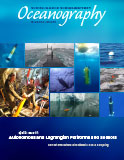First Paragraph
A combination of thermohaline circulation and monsoon-modulated winds drive advection in the Red Sea. Biogeochemical processes are closely coupled with the physical dynamics of the sea, yet to date remain poorly resolved and understood. Given the Red Sea’s size (~2,000 km × 250 km), frequently occurring eddies can provide a mechanism for significant exchange between the open sea and its abundant coastal coral reef regions. Because no international waters exist within the Red Sea, and geopolitical restrictions allow only limited access, our most complete understanding of the Red Sea until recently has come from remote sensing and numerical modeling studies (e.g., Sofianos and Johns, 2002; Raitsos et al., 2013; Yao et al, 2014; Racault et al., 2015), although occasional ship expeditions have provided in situ observations with limited temporal and/or spatial coverage (e.g., Naqvi et al., 1986; Sofianos and Johns, 2007; Bower and Farrar, 2015; Kürten et al., 2016).

